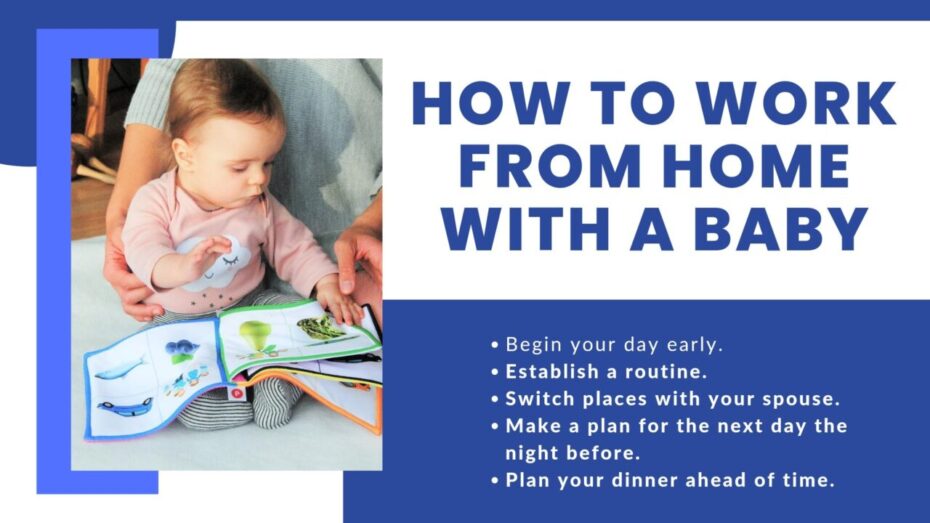Table of Contents
How to work from home with a baby? Working from home with a baby can be challenging, but it is manageable with the right strategies. This guide provides practical tips and tricks to help you balance your professional responsibilities and parenthood. Let’s explore how to work from home with a baby effectively.
1. Create a Flexible Work Schedule
Creating a flexible work schedule is essential when figuring out how to work from home with a baby. Flexibility allows you to adapt to your baby’s needs while still meeting your professional responsibilities. This approach helps reduce stress and increases productivity, making it easier to manage both work and parenting duties.
To create a flexible work schedule, start by identifying the most critical tasks and deadlines. Prioritize these tasks and allocate specific time slots during the day when you can focus on them. Be prepared to adjust your schedule as needed, especially if your baby’s routine changes.
Using tools like online calendars and task management apps can help you stay organized and on track. These tools can also help you communicate your availability to colleagues, ensuring that everyone is on the same page.
How Can You Balance Work Hours with Baby’s Routine?
Balancing work hours with your baby’s routine requires careful planning and adaptability. One effective strategy is to synchronize your work schedule with your baby’s sleep and feeding times. Use your baby’s nap times to tackle high-priority tasks that require intense focus.
For example, if your baby naps for two hours in the morning and another two hours in the afternoon, use these windows to complete the most demanding tasks. During your baby’s awake times, focus on lighter tasks that are easier to pause and resume, such as checking emails or making phone calls.
Another tip is to establish a consistent daily routine that aligns with your baby’s natural patterns. This routine provides a sense of predictability for both you and your baby, making it easier to manage work and childcare responsibilities.
Consider involving your partner or other family members in your routine. They can take over childcare duties during critical work hours, giving you uninterrupted time to focus on your tasks. Open communication and a shared calendar can help coordinate these efforts effectively.
Best Time Management Tips for Parents
Effective time management is crucial for parents working from home with a baby. Start by setting clear goals for each day, breaking them down into manageable tasks. This approach helps you stay focused and ensures that you make consistent progress, even on busy days.
Using a time-blocking technique can also be beneficial. Allocate specific time blocks for different types of tasks, such as focused work, meetings, and breaks. Be sure to include buffer times between blocks to accommodate any unexpected interruptions from your baby.
Another helpful tip is to prioritize tasks based on their importance and urgency. The Eisenhower Matrix is a useful tool for this purpose, allowing you to categorize tasks into four quadrants: urgent and important, important but not urgent, urgent but not important, and neither urgent nor important. Focus on tasks in the first two categories to maximize your productivity.
Utilizing productivity apps can further enhance your time management. Apps like Trello, Asana, or Todoist allow you to track your tasks, set deadlines, and receive reminders, ensuring that nothing falls through the cracks.
How to Prioritize Tasks Efficiently
Prioritizing tasks efficiently is key to balancing work and childcare. Start each day by listing all the tasks you need to complete, then rank them based on their importance and deadlines. This approach helps you focus on what truly matters and avoid getting overwhelmed by a long to-do list.
Consider using the ABCDE method to prioritize tasks. Label each task with a letter: A for high-priority tasks, B for important but less urgent tasks, C for nice-to-do tasks, D for tasks you can delegate, and E for tasks you can eliminate. Focus on completing A tasks first before moving on to B and C tasks.
Delegating tasks is another effective way to manage your workload. Identify tasks that can be handled by others, whether it’s a colleague at work or a family member at home. Delegation allows you to focus on the most critical tasks and ensures that everything gets done efficiently.
Finally, learn to say no to non-essential tasks and commitments. It’s important to protect your time and energy, especially when juggling work and childcare. Politely declining additional responsibilities can help you maintain a manageable workload and reduce stress.
2. Designate a Dedicated Workspace
Designating a dedicated workspace is crucial for successfully working from home with a baby. Having a specific area for work helps create a clear boundary between professional and personal life, making it easier to focus on tasks without constant interruptions. A well-organized workspace can boost productivity and reduce stress, helping you manage your work and childcare responsibilities more effectively.
When setting up your workspace, choose a quiet area of your home where you can work without too many distractions. This space should be comfortable, well-lit, and equipped with all the necessary tools and resources to perform your job efficiently. Personalize this area to make it inviting and motivating, but keep it functional and clutter-free to maintain a professional atmosphere.
How to Set Up a Baby-Friendly Home Office
Creating a baby-friendly home office is essential for parents working from home with a baby. Start by selecting a safe and accessible area where you can keep an eye on your baby while working. Ensure the space is baby-proofed with safety gates, outlet covers, and secure furniture to prevent accidents.
Integrate a play area within your workspace where your baby can safely play and explore. Fill this area with age-appropriate toys, books, and activities to keep your baby entertained. Consider using a playpen or a baby swing to keep your baby in sight while providing them with a safe space to move around.
To make the most of your work hours, position your baby’s essentials, such as diapers, wipes, and snacks, within arm’s reach. This setup allows you to quickly attend to your baby’s needs without having to leave your workspace. Additionally, use a comfortable chair and a sturdy desk to create an ergonomic workstation that supports long hours of work.
Organize your workspace to minimize clutter and maximize efficiency. Use storage solutions like shelves, drawers, and baskets to keep your office supplies and baby items neatly arranged. A tidy workspace helps you stay focused and reduces the time spent searching for necessary items.
Essential Equipment for Your Home Workspace
Equipping your home workspace with the right tools is vital for maintaining productivity while working from home with a baby. Invest in a reliable computer, high-speed internet connection, and essential software to ensure smooth and uninterrupted workflow. A high-quality headset with a microphone can be invaluable for virtual meetings, helping you communicate clearly without background noise.
A multifunction printer and scanner can also be beneficial for handling paperwork and digital documents efficiently. Additionally, consider using a second monitor to enhance your productivity by allowing you to multitask more effectively.
Ergonomic furniture is another important investment. Choose a comfortable chair with good lumbar support and an adjustable desk to maintain a healthy posture throughout the day. Proper ergonomics can prevent physical strain and improve overall work efficiency.
To manage your time effectively, use productivity tools such as task management apps, calendar software, and time-tracking programs. These tools help you stay organized, prioritize tasks, and meet deadlines while balancing childcare duties.
How to Minimize Distractions While Working
Minimizing distractions is essential for staying productive when working from home with a baby. One effective strategy is to set clear boundaries with family members about your work hours and the importance of minimizing interruptions. Communicate your schedule to ensure everyone understands when you need focused time.
Another helpful tactic is to use noise-canceling headphones to block out background noise and create a more focused work environment. Listening to instrumental music or white noise can also help drown out household sounds and improve concentration.
Implementing a daily routine that aligns with your baby’s schedule can reduce disruptions. Plan your work tasks around your baby’s nap and feeding times, ensuring you have dedicated periods of uninterrupted work. Utilize these quiet times for high-priority tasks that require intense focus.
Finally, keep your workspace organized and free from distractions. Avoid having personal items, such as your phone or non-work-related materials, within easy reach. This setup helps you stay on task and reduces the temptation to engage in non-work activities during work hours.
3. Utilize Nap Times Effectively
Utilizing nap times effectively is key when figuring out how to work from home with a baby. These quiet periods offer golden opportunities to focus on tasks that require your full attention without distractions. By planning your work around your baby’s nap schedule, you can maximize productivity and achieve a balanced work-life routine.
To make the most of nap times, prepare a list of high-priority tasks that can be accomplished during these windows. This proactive approach ensures that you are ready to dive into work as soon as your baby falls asleep. Consistency in your baby’s nap routine can also help you establish a predictable work schedule, making it easier to manage your workload.
What Tasks Are Best During Baby’s Nap Time?
High-focus tasks are best tackled during your baby’s nap time. This period is perfect for activities that require concentration and uninterrupted time, such as writing reports, attending virtual meetings, or engaging in creative work. Using this time for critical thinking and problem-solving tasks can significantly boost your productivity.
Another effective strategy is to handle tasks that involve detailed planning or complex projects during naps. This includes drafting project proposals, developing marketing strategies, or analyzing data. Utilizing this quiet time for such tasks helps ensure you can work without the usual distractions, allowing for more efficient and higher-quality output.
Additionally, nap times are ideal for completing tasks that benefit from a quiet environment, such as recording audio or video content. Without background noise, you can produce clear and professional recordings. This approach helps you make the most of these valuable quiet moments.
It’s also beneficial to plan and prioritize tasks before your baby’s nap time begins. Having a clear plan ready allows you to start working immediately, maximizing the use of this uninterrupted period. This preparation minimizes downtime and keeps you focused on what needs to be done.
How to Optimize Productivity in Short Bursts
Optimizing productivity in short bursts is a powerful technique when working from home with a baby. One effective method is to use the Pomodoro Technique, which involves working for 25 minutes followed by a 5-minute break. This approach helps maintain focus and prevents burnout, making the most of your limited time.
Another strategy is to set clear, achievable goals for each work session. Breaking down larger projects into smaller, manageable tasks can help you stay focused and accomplish more in less time. Clear goals provide direction and help you measure progress, keeping you motivated.
Eliminating distractions is crucial for optimizing productivity in short bursts. Create a dedicated workspace free from interruptions and set boundaries with family members about your work periods. Using noise-canceling headphones or background music can also help maintain focus.
Utilizing productivity tools such as task management apps and timers can further enhance your efficiency. These tools help you stay organized, track progress, and allocate time effectively. They provide structure to your work sessions, ensuring you remain on track and productive.
Can You Rest During Baby’s Nap Time Too?
Yes, it’s important to rest during your baby’s nap time too. While it’s tempting to use every quiet moment for work, taking breaks to recharge is essential for maintaining your overall well-being. Resting can improve your focus, creativity, and productivity in the long run.
To balance work and rest, consider allocating a portion of your baby’s nap time for relaxation. Even a short 15-20 minute break can make a significant difference in your energy levels. Use this time for activities that help you unwind, such as reading, meditating, or simply enjoying a quiet moment.
Listening to your body’s needs and not overworking yourself is crucial. Fatigue can lead to decreased productivity and increased stress, affecting your ability to balance work and childcare effectively. Prioritizing self-care ensures you have the energy and mental clarity to handle both responsibilities.
Incorporating rest into your routine can also set a positive example for your baby. It shows the importance of taking breaks and looking after oneself, fostering a healthy work-life balance from an early age. By taking care of yourself, you can better take care of your baby and manage your work responsibilities efficiently.
4. Implement Baby Entertainment Strategies
Implementing baby entertainment strategies is crucial for parents figuring out how to work from home with a baby. Keeping your baby engaged and happy ensures you can focus on your work tasks without constant interruptions. These strategies can significantly improve your productivity and create a harmonious work-from-home environment.
To keep your baby entertained, introduce a variety of activities that are both fun and stimulating. A mix of sensory play, interactive toys, and safe physical activities can capture your baby’s attention and provide the mental and physical stimulation they need. Regularly changing activities helps maintain their interest and prevents boredom.
How to Keep Your Baby Engaged and Happy
Keeping your baby engaged and happy involves providing a mix of activities that cater to their developmental needs. Sensory play is particularly effective; activities like playing with textured toys, water play, or exploring different sounds can captivate your baby’s interest. Sensory experiences are not only entertaining but also crucial for cognitive development.
Interactive play is another excellent way to keep your baby engaged. Toys that respond to your baby’s actions, like musical instruments or activity centers, can provide endless entertainment. Encouraging your baby to explore and interact with these toys helps develop their motor skills and keeps them occupied for longer periods.
Additionally, storytelling and reading are powerful tools for engagement. Reading books with colorful pictures and varied textures can capture your baby’s attention. Using different voices and expressions while reading makes the experience more enjoyable and beneficial for language development.
Engaging your baby in physical activities like tummy time or guided crawling can also keep them happy. These activities not only entertain but also help build strength and coordination. Creating a safe play area where your baby can move freely allows them to explore and play independently while you work.
Safe and Fun Activities for Babies
Choosing safe and fun activities for your baby ensures they stay entertained without any risk. Sensory bins filled with non-toxic, baby-safe materials like water beads or rice can provide hours of exploratory play. Supervise these activities to ensure safety while allowing your baby to enjoy different textures and colors.
Musical play is another safe and fun option. Instruments like baby drums, xylophones, or even simple rattles can engage your baby and foster a love for music. Singing songs and nursery rhymes together can also be a delightful bonding activity that stimulates auditory development.
Artistic activities like finger painting with edible, baby-safe paints or drawing with jumbo crayons can be both fun and safe. These activities allow your baby to express creativity while improving fine motor skills. Always ensure that the materials used are non-toxic and suitable for babies.
Outdoor play, if weather permits, is highly beneficial. Simple activities like playing on a blanket in the yard, watching birds, or exploring nature can be exciting and educational. Fresh air and a change of scenery can also do wonders for your baby’s mood and energy levels.
How to Rotate Toys to Maintain Interest
Rotating toys is an effective strategy to maintain your baby’s interest and prevent boredom. Start by dividing your baby’s toys into different groups. Each week, introduce a new group of toys while storing the others out of sight. This rotation keeps toys feeling fresh and exciting.
Observe your baby’s preferences and adjust the rotation accordingly. If a particular toy or activity is especially engaging, keep it in the rotation longer. Conversely, if your baby loses interest in a toy, retire it temporarily and reintroduce it later.
Incorporate a mix of toys that cater to different developmental needs. Include sensory toys, interactive toys, and simple objects like stacking cups or soft blocks. This variety ensures your baby has a balanced play experience that stimulates different areas of development.
Regularly cleaning and maintaining toys ensures they remain safe and appealing. Broken or worn-out toys should be repaired or replaced to prevent any potential hazards. Keeping toys in good condition extends their lifespan and maintains your baby’s interest.
5. Leverage Technology for Assistance
Leveraging technology can be a game-changer when working from home with a baby. From productivity apps to baby monitors, various tools can help you manage your tasks more efficiently and keep an eye on your little one. Integrating these technologies into your daily routine can enhance your productivity and peace of mind.
Using technology strategically can streamline your workflow and free up more time for both work and family. Many apps and devices are designed to assist parents in balancing their responsibilities, making it easier to stay organized and focused.
Best Apps for Working Parents
Several apps are designed specifically to help working parents balance their professional and personal lives. Productivity apps like Trello and Asana can help you manage your tasks, set deadlines, and collaborate with colleagues. These tools allow you to organize your work efficiently and stay on top of your responsibilities.
Family organization apps like Cozi can be invaluable for coordinating schedules and tasks among family members. This app allows you to create shared calendars, to-do lists, and grocery lists, ensuring everyone is on the same page and responsibilities are evenly distributed.
For managing childcare, apps like Baby Connect offer comprehensive tracking of your baby’s schedule, including feedings, naps, and diaper changes. This detailed information can help you anticipate your baby’s needs and plan your work tasks around their routine.
Relaxation and mindfulness apps like Headspace or Calm can also be beneficial for managing stress. These apps offer guided meditations and relaxation exercises that can help you stay calm and focused throughout your busy day.
How Can Virtual Assistants Help Manage Tasks?
Virtual assistants can be incredibly helpful in managing tasks and reducing your workload. Tools like Amazon Alexa or Google Assistant can handle various tasks such as setting reminders, creating shopping lists, and even controlling smart home devices. These assistants can streamline your daily routine and help you stay organized.
Using a virtual assistant to manage your calendar and schedule appointments can free up valuable time. Simply voice your commands, and the assistant will handle the rest, ensuring you don’t miss any important meetings or deadlines.
Virtual assistants can also help with meal planning and grocery shopping. By creating shopping lists and placing orders online, these tools can save you time and effort, allowing you to focus on work and childcare.
Additionally, virtual assistants can provide quick answers to questions, play music or podcasts, and even entertain your baby with stories and songs. This versatility makes them a valuable addition to any home, enhancing both productivity and convenience.
Tools for Monitoring Baby While Working
Monitoring your baby while working is crucial for peace of mind and safety. Baby monitors, especially those with video capabilities, allow you to keep an eye on your baby without needing to be in the same room. Modern baby monitors often come with additional features like temperature sensors, night vision, and two-way audio.
Smart baby monitors that connect to your smartphone provide real-time alerts and updates. These devices can notify you of any unusual activity or sound, allowing you to respond promptly. Some advanced monitors even track your baby’s sleep patterns and breathing, offering detailed insights into their well-being.
Wearable baby monitors are another innovative solution. These devices attach to your baby’s clothing and monitor vital signs like heart rate and oxygen levels. Data is sent to your smartphone, giving you constant updates and ensuring your baby’s safety.
Integrating a surveillance system with multiple cameras can also be effective. Placing cameras in key areas of your home allows you to monitor your baby’s activities from different angles. Accessing the camera feed through your smartphone or computer ensures you can work with confidence, knowing your baby is safe.
6. Establish Boundaries with Family Members
Establishing boundaries with family members is crucial when learning how to work from home with a baby. Clear boundaries help create a work environment where you can focus on your tasks without constant interruptions. This balance ensures that both your work and family needs are met efficiently.
To set effective boundaries, start by having open discussions with your family about your work schedule and the importance of minimizing distractions. Explain your work needs and how their cooperation can help you be more productive. This understanding can foster a supportive environment where everyone works together to achieve a harmonious balance.
How to Communicate Your Work Needs
Communicating your work needs clearly is essential for establishing boundaries with family members. Begin by setting specific work hours and sharing this schedule with your family. Clearly define times when you should not be disturbed unless it’s an emergency. This clarity helps your family understand when you need to focus and when you are available.
Use a shared calendar to keep everyone informed about your work commitments and deadlines. This visual tool helps your family see when you have important meetings or tasks, reducing the likelihood of interruptions. Regularly updating this calendar ensures everyone stays on the same page.
It’s also helpful to create a physical sign or indicator for your workspace that signals when you are working. This could be a closed door, a “Do Not Disturb” sign, or any other visual cue that alerts family members to respect your work time. Establishing these signals helps reinforce the boundaries you’ve set.
Have regular check-ins with your family to discuss how the boundaries are working and make any necessary adjustments. This ongoing communication ensures that everyone’s needs are being met and helps maintain a supportive and cooperative home environment.
Importance of a Support System
Having a strong support system is vital when working from home with a baby. Family members, friends, and even professional help can provide the assistance you need to balance work and childcare responsibilities effectively. A reliable support system can significantly reduce stress and improve your overall well-being.
Support from your partner or other family members can include taking over childcare duties during critical work hours, helping with household chores, or simply providing emotional support. This shared responsibility allows you to focus on your work while ensuring your baby’s needs are met.
Friends and neighbors can also be part of your support system. They might offer to watch your baby for short periods, provide a listening ear, or run errands for you. These small acts of kindness can make a big difference in managing your daily tasks and maintaining your productivity.
Professional services such as daycare, babysitters, or house cleaners can provide additional support. While these services come at a cost, they can offer peace of mind and valuable time to concentrate on your work. Investing in professional help can be a worthwhile decision for maintaining a balanced and efficient home life.
How Can Family Members Assist During Work Hours?
Family members can play a crucial role in helping you manage work and childcare. Assigning specific tasks to family members can ensure that everyone contributes to a smoothly running household. For example, an older child can help with light chores, or a partner can handle meal preparations.
Grandparents or other relatives can also assist by spending quality time with your baby, engaging them in activities, or taking them for walks. This involvement not only provides you with uninterrupted work time but also strengthens family bonds and enriches your baby’s social development.
Establishing a routine where family members take turns looking after your baby during your work hours can be highly effective. This rotation ensures that no one person is overwhelmed and that you have consistent support throughout the day. Clear communication and planning are key to making this system work smoothly.
Encouraging family members to engage in interactive play, reading, or educational activities with your baby can be very beneficial. These activities keep your baby entertained and stimulated while allowing you to focus on your work tasks. Providing family members with a list of your baby’s favorite activities can help them feel more confident in their caregiving role.
7. Practice Self-Care and Maintain Balance
Practicing self-care and maintaining balance are essential when working from home with a baby. Taking care of your mental and physical health ensures you can manage both work and parenting responsibilities effectively. Incorporating self-care into your routine helps prevent burnout and promotes overall well-being.
Balancing work and self-care requires intentional planning and commitment. Set aside time each day for activities that help you relax and recharge. This balance is crucial for sustaining your productivity and maintaining a positive mindset, allowing you to be the best parent and professional you can be.
How to Incorporate Breaks for Mental Health
Incorporating breaks for mental health throughout your workday is vital. Short, regular breaks can help reduce stress and improve focus. Consider techniques like the Pomodoro Technique, which involves working for 25 minutes and then taking a 5-minute break. This method can enhance productivity and keep you mentally refreshed.
During your breaks, engage in activities that help you unwind. This could include deep breathing exercises, stretching, or a quick walk outside. These activities can reduce tension and clear your mind, making it easier to return to work with renewed energy.
It’s also beneficial to practice mindfulness or meditation during breaks. Even a few minutes of mindfulness can improve concentration and reduce anxiety. Apps like Headspace or Calm offer guided meditations that can fit into short breaks, providing a mental reset.
Creating a designated relaxation space in your home can also be helpful. This space can be a cozy corner with a comfortable chair, soft lighting, and calming decor where you can take your breaks and practice relaxation techniques. Having a special place to unwind can make your breaks more effective.
Importance of Physical Activity and Exercise
Physical activity and exercise play a crucial role in maintaining balance when working from home with a baby. Regular exercise boosts energy levels, improves mood, and enhances overall health. Integrating physical activity into your daily routine can help you manage stress and stay productive.
Consider starting your day with a quick workout to boost your energy and set a positive tone for the day. This could be a brisk walk, a short yoga session, or a home workout routine. Morning exercise can improve your focus and productivity throughout the day.
Incorporating physical activity into your breaks is another effective strategy. Simple exercises like stretching, jumping jacks, or a quick dance session can help break up long periods of sitting and keep your body active. These mini-workouts can re-energize you and improve your concentration.
Involving your baby in physical activities can also be beneficial. Activities like stroller walks, baby yoga, or playing on the floor can provide both you and your baby with essential exercise. This shared activity strengthens your bond and ensures you both get the physical activity you need.
How to Find Time for Personal Interests
Finding time for personal interests is essential for maintaining a balanced life when working from home with a baby. Pursuing hobbies and activities you enjoy can provide a much-needed mental break and improve your overall happiness. Scheduling time for personal interests helps ensure you don’t neglect your own needs.
Identify pockets of time in your daily schedule where you can engage in activities you love. This could be early in the morning before your baby wakes up, during nap times, or in the evening after your baby goes to sleep. Consistently dedicating time to your hobbies helps maintain your interests and passions.
Combine personal interests with family activities when possible. For example, if you enjoy cooking, involve your baby in simple kitchen tasks or let them play nearby while you cook. This approach allows you to pursue your interests while still spending quality time with your baby.
Joining online groups or communities related to your interests can provide additional motivation and support. Engaging with others who share your hobbies can inspire you to make time for these activities and offer a sense of connection and fulfillment. This social interaction can be a valuable part of your self-care routine.






